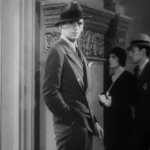 |
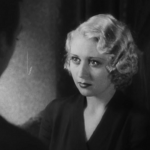 |
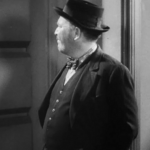 |
| Chick Douglas Fairbanks Jr. |
Ruth Joan Blondell |
Scrap Iron Guy Kibbee |
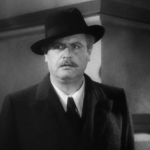 |
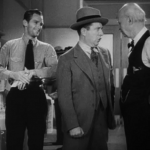 |
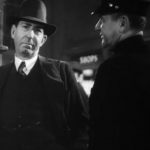 |
| Bushy Sloan Alan Hale |
The Drunk Frank McHugh |
Kendall David Landau |
| Released by Warner Brothers | Directed By Alfred E. Green |
||
Proof That It’s Pre-Code
- The film’s opening minutes read like a checklist of Code no-nos. There are prostitutes, a woman heading to Reno for a divorce, unplanned pregnancies, legs and more legs, extramarital affairs, drinking out of flasks a plenty, and much more.
- The main couple of the film– Chick and Ruth– meet after Chick mistakes her for a prostitute and takes her back to a hotel for a good time. He even slaps her when he finds out the truth when she starts crying instead of putting out. Let’s see you do that, Sound of Music!
- Ruth is also stalked by a, uh, stalker. He’s a man who wore dark glasses with poor eyesight whom she’d read books to. Dirty books, at his request. Now he’s after her to fulfill his fantasies.
Union Depot: The Crossroads of Life
“I tried to sell her on the idea of me being a gentleman.”
It’s pretty safe to say that the primary means of transportation have shifted in this country over the last 80 years. Where once cruise ships, buses and trains carried people across the globe, the faster, cheaper airplane has stepped in to grab much of the traffic. Trains in particular have lost nearly all of their luster. It doesn’t help that they’re a slow mode of transport– if you want to get from Los Angeles to New York, expect to spend 64 hours and $1,500 if you want a sleeper. Considering it costs me less than that to hit Hawaii for a few nights, I may pass.
But that wasn’t always so, as you can surmise. The train station of the 1930s was a hub for people of every social strata as they make their way across the country, either towards fortunes or away from troubles. From vagrants and criminals to the rich and famous to the black, white, and Asian, anyone could cross paths at the local depot.
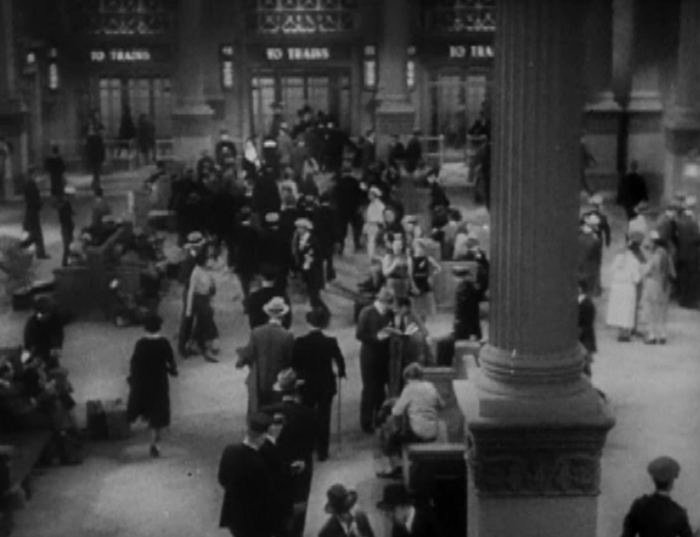
The train station of the 30s.
Warner’s Union Depot uses this setup to recreate a microcosm of Depression Era America. And since it’s a Warners picture, you get to look at it from the bottom up. Our main character is a ‘forgotten man’ named Chick, a hobo who travels across the country by rail looking for work and getting in and out of jams. Union Depot is the story how one night by luck, good and bad, everything gets flipped upside down, switching him from pauper to prince.
Chick travels the country with his friend Scrap Iron. The two just got out of another jail term for vagrancy (as hard it is to believe, America may have a raging boner for putting poor people behind bars) and have decided that their best chance to avoid another dinner of hobo beans is for Chick to borrow an information clerk’s uniform and see if it packs any privileges. Before he gets a chance to find out, he accidentally returns it to its rightful owner. However, Chick’s life is charmed when another passenger leaves a bag behind, giving him a fresh suit, a wad of dollar bills, and a shaving kit to make him look a bit presentable. Not that Douglas Fairbanks looks bad with a bit of stubble, but, hey, couldn’t hurt.
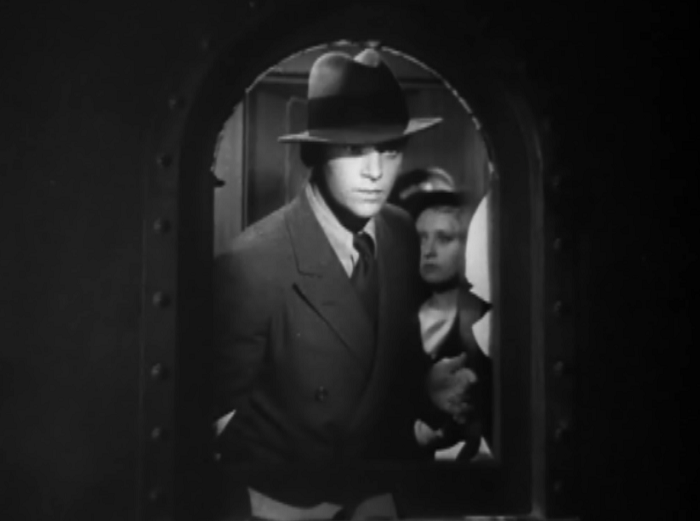
Damnably handsome Douglas Fairbanks Jr.
After falling up the social ladder by a few degrees, the first thing he does is seek out dinner. The second is female companionship. He finds a lonely looking Ruth starring off into the distance, and mistaking her big eyes for something else, invites her across the street for a private meal. Only it’s not a restaurant they attend, but a private dining room with a fainting couch. Here’s where he finds out she’s not a prostitute, and slaps her across the face, chiding her for her deception and asking her what would have happened if he was one of those guys who wouldn’t have stopped. So in case you ever wondered, yeah, date rape was totally a thing in the 30s.
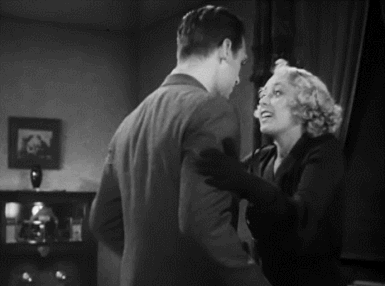
I didn’t want to make the .gif too big, so you miss the record scratch that indicates an unsuccessful attempt to couple.
But Chick ain’t a guy like that, and with a wad of cash in his pocket, promises to help Ruth out of her jam. She needs $64.50 to make it to Salt Lake City and rejoin her traveling troupe as a chorus girl, and Chick supplies it. But there are two complications to the situation: Dr. Bernardi, an old man who wears sunglasses constantly and limps just for extra evil effect, is after Ruth for her virtue and his own perversions. (So in case you wondered, yes, ‘rape’ rape was totally a thing too.) Then there’s also Bushy Sloan, a counterfeiter, whose money accidentally ends up in Scrap Iron’s hands. He wants it back, but not before he can sick the FBI agent Kendall on Chick rather than himself.
If this all seems a little contrived, well, yeah. A drama is still a drama by any other name. But at the core are Fairbanks and Blondell. Fairbanks has come a long way in the talkies, and perfected his ‘Clark Gable without the danger’ persona. He’s brusque, but you can tell he’s a softie from the first time we see him. Blondell, only on her second year in Hollywood but still marking this as her 16th film (right after Blonde Crazy), is both sensitive and sweet. Her big eyes get to work overtime as she struggles to overcome her frustration as missteps plague her attempts to get to Salt Lake City; her vocal chords get a workout, too.
Fairbanks also gets a chance to play the action hero, too, much like his father so often did. The film has a lengthy battle in the train yard between Chick and Bushy after Bushy stole back his violin case of counterfeit money and shot an FBI agent. Chick gives chase, and while there is certainly a bounty of stuntmen and rear projection to behold, the finished sequence is still pretty thrilling.
The film does get a little too circular in its final scenes– everyone marches back to Kendall’s office, back outside, back to Kendall’s office, back outside– so much so that the characters even poke fun at it. It gets better by the film’s final moments, and the film’s coda is a beautiful punch in the gut.
Spoilers.
Ruth and Chick, who’ve obviously fallen for each other hard, must split. Even though she’s learned he’s not the generous gentleman he pretended to be, his heart was in the right place– perhaps even righter, since he was giving up so much more to give her a shot at returning to her normal life. After one last kiss and a quick, though hollow, promise to visit her if he ever sees her troupe’s name on the marquee, we know that we are seeing the end of their affair. And, as sometimes happens in life, they will probably never see each other again.
Scrap Iron runs up next to Chick and smiles. Chick unwraps a piece of gum and offers Scrap half as the two walk away from the station, back into the reality of the hobo life and another day on the road. It’s kind of a bittersweet ending, a realization of futility but also of the sublime beauty that one improbable night can bring.
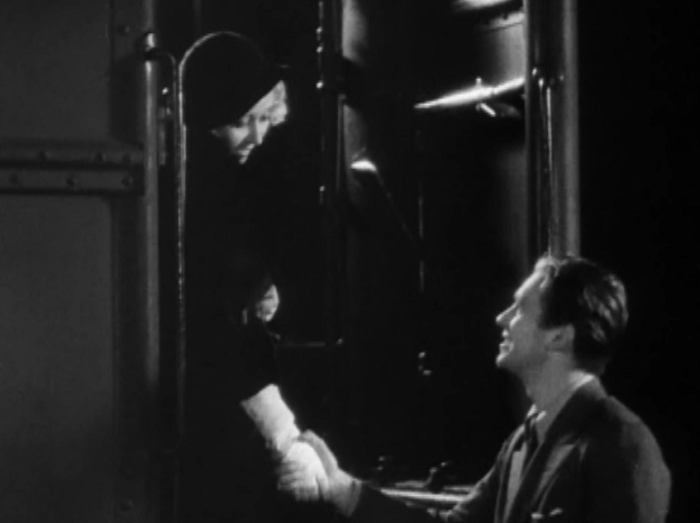
“Good match, good sir!”
The movie carefully parallels Chick and Ruth’s stories to make them an ideal couple. Both are desperate for money and resort to immoral things in attempts to get it. Both are also on the more morally questionable side of society– Ruth, a showgirl with an injured ankle, and Chick, with so little money that vagrancy arrests is pretty much his only constant in life.
They’re also pursued by malicious avatars representing the culminations of their weaknesses and fears. Bushy is a greedy counterfeiter, the ultimate fate of Chick if he were to continue down his ‘money for nothing’ path of misbehavior. He only manages to beat Bushy not with wit, luck, or brutal strength, but just by a person vouching for Chick’s history of kindness and bravery.
Ruth, who pretends to be a prostitute for money, is pursued by Bernardi, a pervert of the highest order. He also represents the ultimate danger inherent in that pathway– sex, whether you want it or not, by cruel, vicious men. Ruth survives the encounter with him when Chick arrives to frighten him off– a clear sign that a loving, moral relationship with a man is the only thing that can save her virtue. (Hey, it’s the 1930s. You can’t always expect The Feminine Mystique.)
End spoilers.
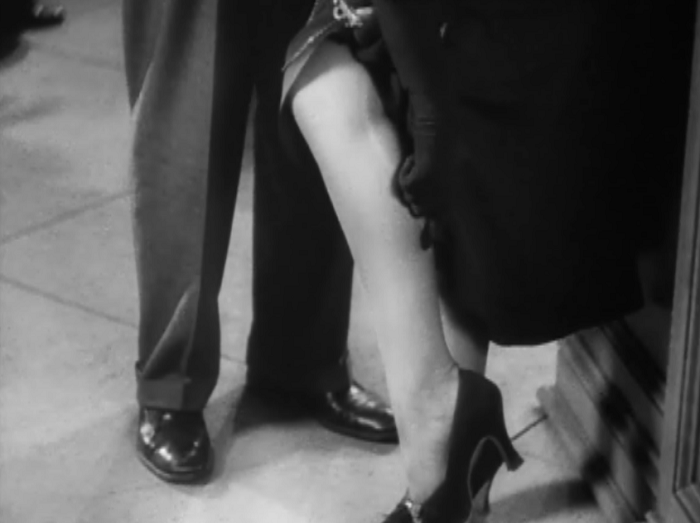
Case in point: the number of gams present in the film.
Union Depot is a social mobility parable, an ode to the common guy and every other person who feels left out when they go to the movies. Chick’s change of class doesn’t change him as a person. He’s generous and kind, wanting only the best for people. However, it’s not until he has cash in his pocket that he’s finally able to affect real change, saving Ruth and bringing down a major opponent of good ol’ Uncle Sam. It’s not critical of the government, per se, but of capitalism, and how it forces good men like Chick into a bad position.
It’s also a funny, vibrant story that feels startlingly alive. Director Alfred E. Green’s extraordinarily mobile camera weaves and tracks between the many stories told. It captures more than just the story of Chick and Ruth, but a perfect, Hollywood version of the Depression, with nobility, hope, and charm to spare.
Gallery
Hover over for controls.
Trivia & Links
- A lot of sites vary between calling Fairbanks’ character ‘Chic’ or ‘Chick’. IMDB has it as ‘Chic’, but it’s pronounced as ‘Chick’ in the movie so I choose to go with that spelling. And now you know!
- Here’s TCMDB on Blondell’s bit in the movie and her early career in general:
Blondell’s scenes give the film a sexual edge rarely seen after censorship reared its ugly head in 1934. On the run from a sexual predator who very clearly intends to rape her, she tries to earn train fare to a promised job in Salt Lake City by coming on to Fairbanks. Audiences used to Blondell’s later work as a character actress are often surprised by the blatant sexuality of her early performances. In many ways, she was Warners’ resident hooker with a heart of gold, even when she stopped short of turning tricks, as in Union Depot. She also was one of the studio’s most generously endowed leading ladies. Her more sensual appearances were often cut by film censors and generated memos from production chief Darryl F. Zanuck about keeping her breasts covered so the studio could actually release her movies.
- The film’s British title, coming from the film’s last few lines, was Gentleman for a Day. For the curious, the movie had nothing to do with Frank Capra’s Lady for a Day, which would come out the next year in 1933.
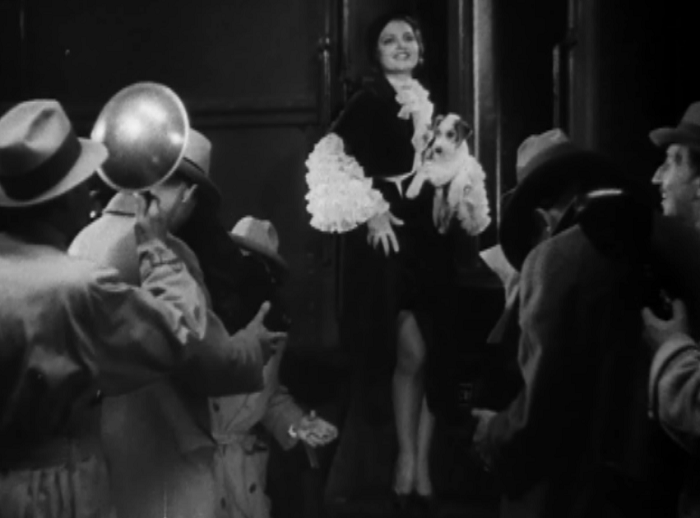
Pre-Code dog watch: A cute Jack Russell gets to hang out with this would-be starlet as she gives the cameramen what they want.
- Cliff over at Immortal Ephemera has some kind words for the movie, but some not-so-kind-words for its portrayal of African-Americans. I’ll be honest, I don’t really see much in the latter point. The black characters in the movie are mostly subservient, working in the bathrooms, as janitors, and as railway men, but those were common jobs for them at the time. There’s also one bit near the beginning where a black woman implores her husband to stay faithful to her while out on the railway; he promises and the train departs, and a well-dressed black man steps off the end of the trolley. “My husband’s going to be gone for 7 whole days,” she smiles. Frankly, I’ve seen that gag played so often with white actors in pre-Code movies, just the change of skin tone was refreshing. Then again, one of the last pre-Codes I watched featured Willie Best, so maybe it just looks good in comparison.
- Mordaunt Hall in The New York Times seems agreeable to this one, comparing it to the stage version of Grand Hotel (since the movie version would be released several months after Union Depot). They also take a dig at Fairbanks, noting that he “appears to have taken a leaf from James Cagney’s book.”
- Happy Otter is pretty impressed by the movie, kicking off their review with a simple, “Wow.” They also have a bunch of screenshots, too.
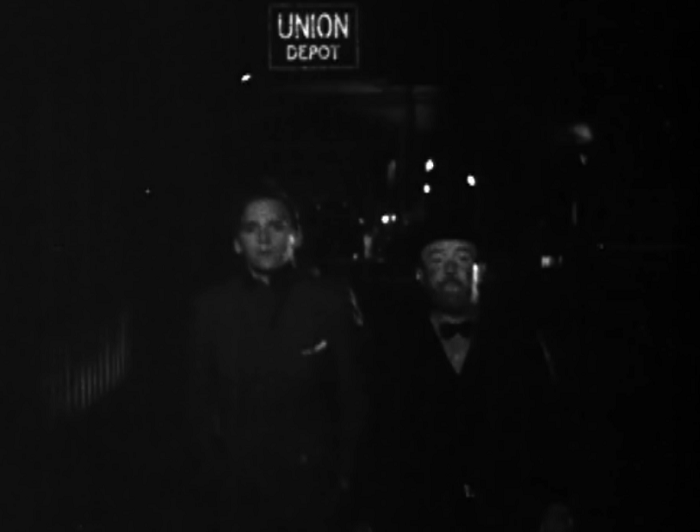
On the road again.
- Mike Grost runs down Alfred E. Green’s direction and talks about Chick’s ability to uplift everyone around him.
- The Man on the Flying Trapeze marvels at the supporting cast of the film and how Warner’s stock company reconfigured themselves so often.
- Finally, Colet and Company runs down the film’s grey morality:
Union Depot is a lot of fun but it also shines a light on the problems of the Depression — namely a lack of opportunity. Everyone in this film is making their own luck (both good and bad), and since this was made in the pre-Code era it’s interesting to see how some crimes are “OK” in this context (Ruth’s amateur prostitution and Chick’s theft of the drunk’s clothes) — since the crimes get them something they genuinely need to get along — and some are not (the counterfeiting, since it just involves greed). This take on relative wrongness would change completely with the enforcement of the Production Code by Joseph Breen in July 1934.
Awards, Accolades & Availability
- This film is available on Amazon and from Warner Archive.
Comment below or join our email subscription list on the sidebar! |
||
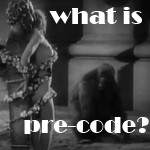 |
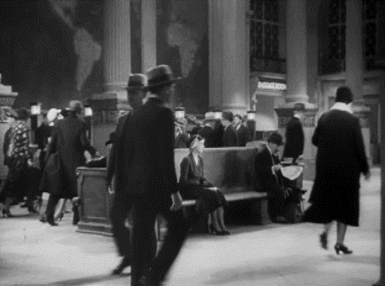 |
 |
 |
 |
|
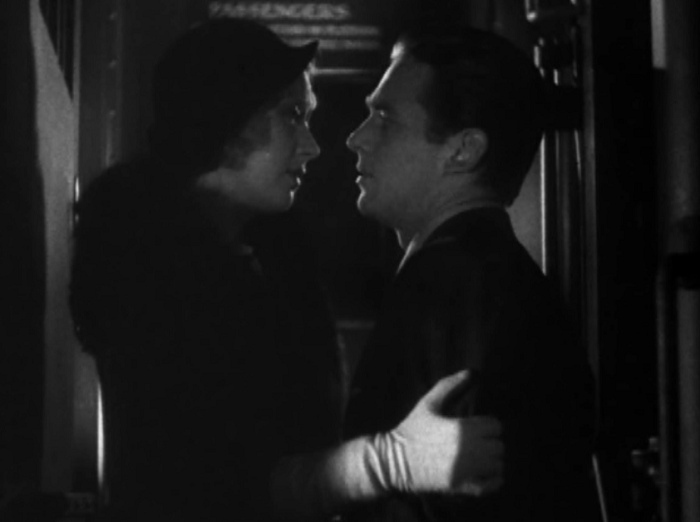

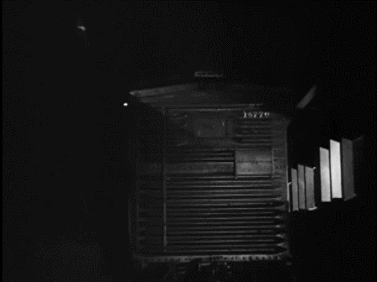
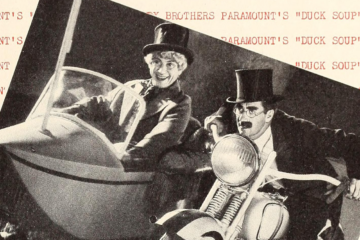


9 Comments
Judy · August 8, 2014 at 7:08 pm
You spurred me on to watch this one, Danny, and I enjoyed it – the rail station atmosphere is great, and Blondell and Fairbanks make a great combination. It’s also good to see so many Warner regulars, like Alan Hale and Frank McHugh. I like your description of it as a “social mobility parable” – there seem to be quite a few of these in the Depression era, with hobos and poor people playing “gentlemen” or “ladies” for a day. The ending was great – “a beautiful punch in the gut” as you say.
The one aspect of the film I found a bit weak was Dr Bernardi – his character made me want to laugh every time he appeared, and I was just waiting for his ridiculous disguise to be removed. Surely he could have been made a bit more realistic and less like someone from a horror B-movie.
Danny · August 8, 2014 at 9:02 pm
I’d like to think there was a Warners story conference where they couldn’t decide if they’d made him seem quite villainous enough and just kept adding strange details one by one. His appearance really reminded me of Peter Lorre in Mad Love (35 I think?) with the glasses and wicked smile, though I’m not sure why the limp was added in on top of that. Probably a sign of impotence? Who knows. I thought he was an effective, anonymous representation of demented perversion, though I think his end was slightly anticlimactic for all of the buildup he’d gotten.
La Faustin · August 8, 2014 at 9:49 pm
Lovely piece on a lovely film — have to throw in this link: http://dcairns.wordpress.com/2009/03/21/johnny-depot/
Danny · August 8, 2014 at 10:40 pm
The idea that Bernardi has syphilis is brilliant and adds to my point above about him representing the dangers of sexual looseness. I really wish I’d picked up on that myself, but now I have ‘symptoms of syphilis’ forever in my search history.
Also, I’d be amazed if the title ‘Grand Depot’ had never been floated around for this.
justjack · August 22, 2014 at 7:37 am
This is such a great Warner’s movie, and I had no idea how good it was going to be when I watched it–does Union Depot have any kind of reputation today? It’s just everything to do with Pre-Code Warner’s. Almost a perfect encapsulation of the studio and the time. I admit I also initially saw Fairbanks as a stand-in for Cagney, but after a while I could see that Fairbanks has a different kind of vibe–more vulnerable, less prone to bust a guy in the nose–in short, more like real life people.
At the time that I watched it, I didn’t pick up on the STD-induced sensitivity to light in Dr. Bernardi. Funnily enough, since that time I read about it in at least two or three historical naval fiction tales.
Finally, the mention of Willie Best. I just don’t know what to say. I’m absolutely aghast at the character he had to portray. Aghast. Did I say aghast? Because he also cracks me up. Watching Willie Best, I’m filled with the kind of mixed feelings that Zap Brannigan experienced when he found out that the Amazons had sentenced him to death by snoo-snoo.
Great film, and great review. Great linked review, too, La Faustin.
Danny · August 27, 2014 at 3:12 pm
I’m honestly amazed by Union Depot’s lack of a reputation. There’s some real magic there. I’m definitely going to chat it up whenever I get a chance!
casey62 · February 3, 2015 at 2:25 am
I love this one – what a great setting! It moves at a brisk pace and packs in quite a lot in 67 minutes. Fairbanks and Blondell are terrific, and the ending has a nice, poignant touch to it. Very unusual that the hero and heroine don’t end up together.
Danny · February 8, 2015 at 1:36 pm
I think it’s a really beautiful ending as it kind of nails that mix between desire and that unspoken understanding of how the world really is. I’m glad you agree.
eo · November 5, 2019 at 5:51 pm
Hi, appreciate all the highlights and sidelights here about one of my all-time favorite not-famous-enough movies.
As an aside, TCM just showed a very entertaining musical short, “Smash Your Baggage,” that looks like it was filmed entirely on Warner Bros’ glorious used and re-used train station set. Unfortunately, very few production notes for “Smash” have made it to the internet, possibly because its African American cast got the usual short shrift in studio records. Most cast members aren’t even identified.
Comments are closed.